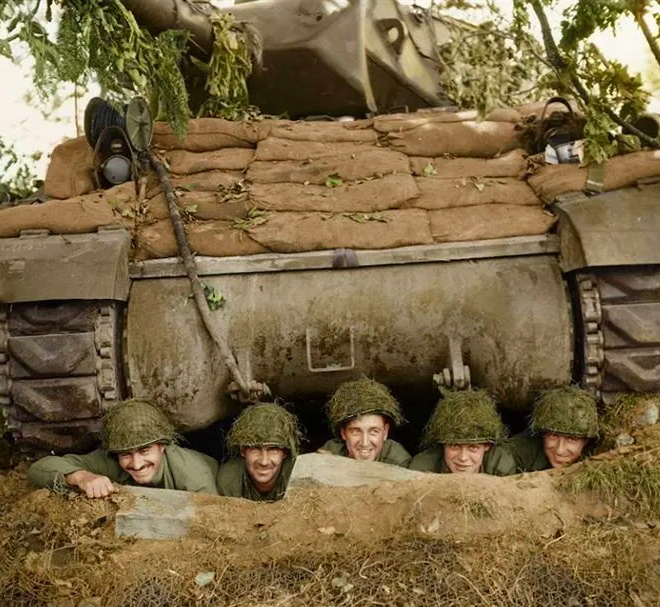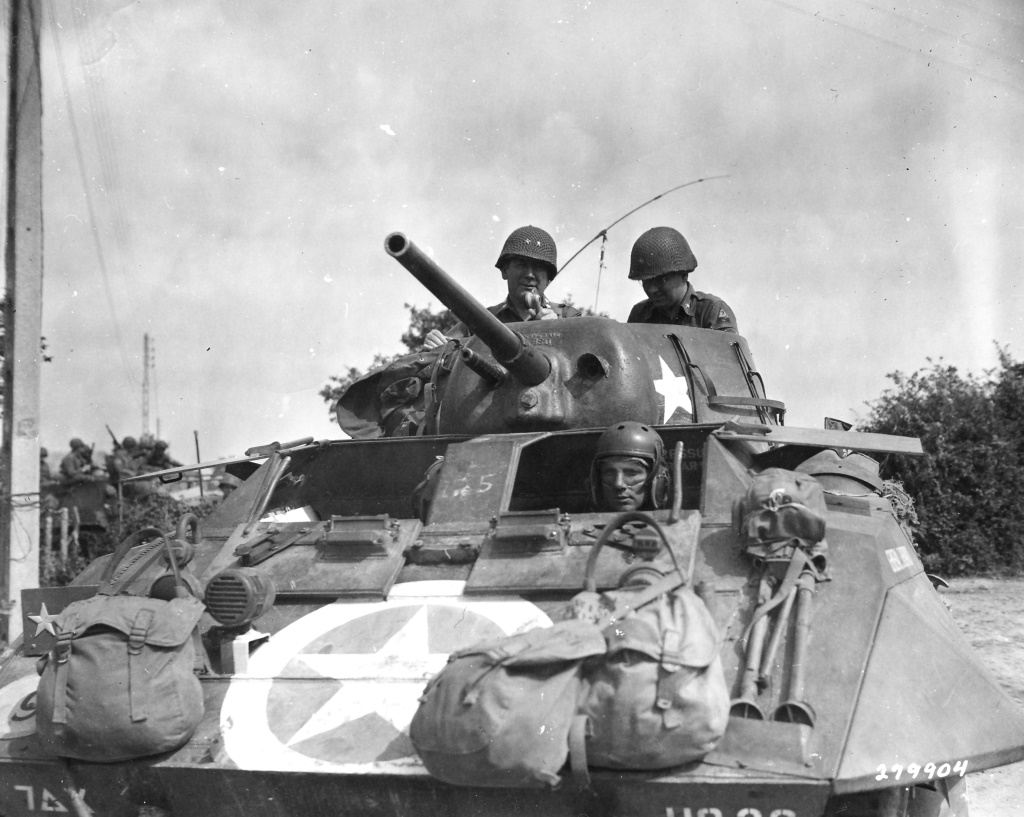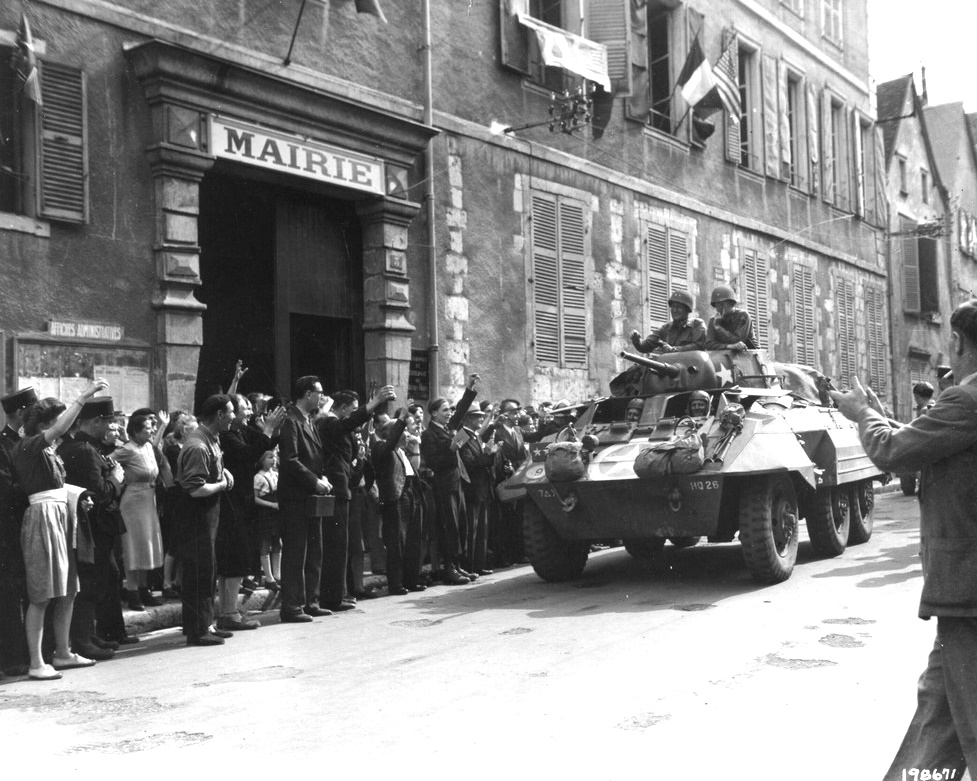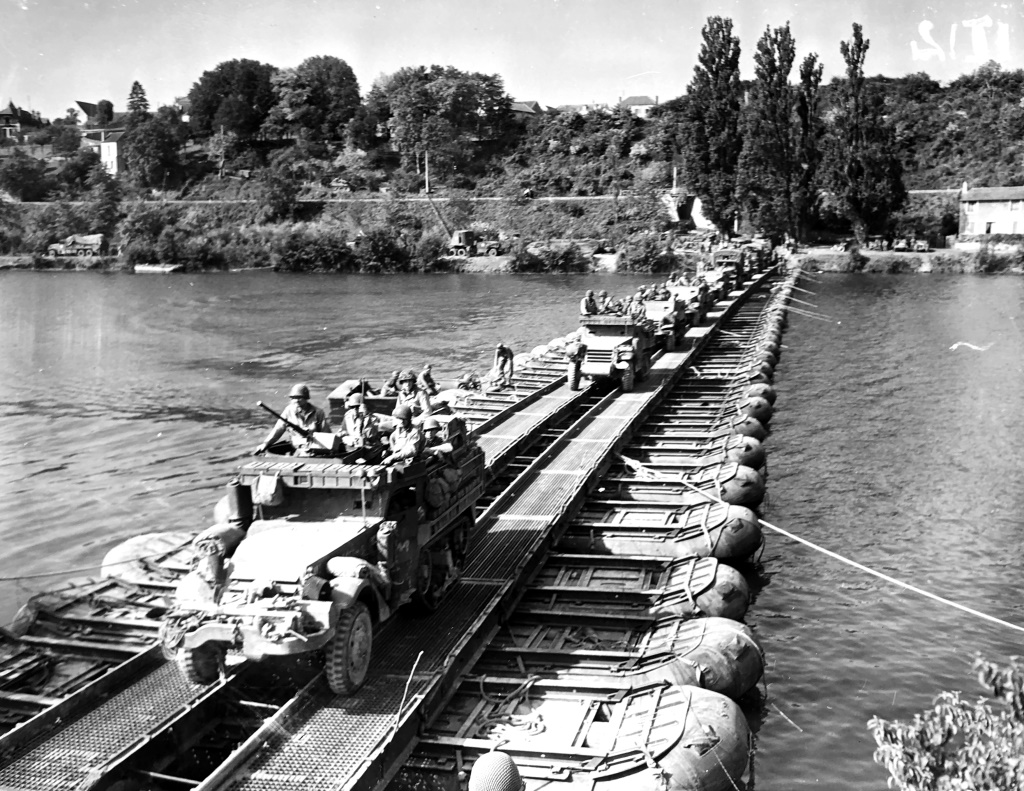Document Source: (Transcribed by Wesley Johnson) Headquarters Twelve Army Group, After Action Report, to The Adjutant General, Washington, D.C., (Thru: Commanding General, European Theater of Operations) Inclosed are After Action Report for the 7th Armored Division and subordinate units for the month of August 1944

HEADQUARTERS 7TH ARMORED DIVISION
Commander by Maj Gen Lindsay McDonald Silvester
CoS Col George H. Molony
CCA Col Dwight A. Rosebaum
CCB Brig Gen John B. Thompson
CCR Lt Col James E. Newberry
Div Arty Col Orville W. Martin
G-1 Lt Col John V. Maxwell
G-2 Lt Col Everett W. Murray
G-3 Lt Col Alvin L. Mente, Jr
G-4 Lt Col Reginald H. Hodgson
Trains Lt Col Andrew J. Adams
17th Tank Bn Lt Col John P. Wemple
31st Tank Bn Lt Col Robert C. Erlenbusch
40th Tank Bn Lt Col Edward T. McConnell
23rd Armd Inf Bn Lt Col Leslie Allison
38th Armd Inf Bn Maj Curtice H. Rankin
48th Armd Inf Bn Lt Col Richard D. Chappuis
434th Armd Field Arty Bn Lt Col James G. Dubuisson
440th Armd Field Arty Bn Lt Col Norman E. Hart
489th Armd Field Arty Bn Lt Col James W. Milner
33rd Armd Eng Bn Lt Col Clyde A. Keltner
77th Armd Med Bn Lt Col Stephen J. Karpenski
87th Cav Recon Sq Mecz Lt Col Vincent L. Boylan
129th Ord Bn Lt Col Hughes
147th Signal Company Capt Hickey
After Action Report August 13, 1944, to August 31, 1944.
Summary of Operations

 The 7th Armored Division landed at Utah Beach and Omaha Beach on August 10/14. Elements of the Division were committed in the Third Army operation to exploit the break-through at Avranches and to encircle Paris from the South, in quick pursuit of a disorganized enemy. Advance elements of the Division were marshalled under XX Corps direction, immediately on landing, in the
The 7th Armored Division landed at Utah Beach and Omaha Beach on August 10/14. Elements of the Division were committed in the Third Army operation to exploit the break-through at Avranches and to encircle Paris from the South, in quick pursuit of a disorganized enemy. Advance elements of the Division were marshalled under XX Corps direction, immediately on landing, in the  vicinity of Ste Suzanne, and ordered to attack northeast to establish an objective on the Seine River in the vicinity of Mantes-Gassicourt.
vicinity of Ste Suzanne, and ordered to attack northeast to establish an objective on the Seine River in the vicinity of Mantes-Gassicourt.
At this time only half of the Division had reached the Ste Suzanne area. On Corps order, the direction of the attack was shifted due east, to establish a bridgehead over the Seine River in the area of Melun. During this attack, there was a major engagement with a rear guard at Chartres, on August 15-19. Isolated resistance was encountered on the route of march and another major engagement was fought at Melun on August 22/24, in the process of establishing a bridgehead. The Division was immediately ordered to continue the pursuit of the enemy to the town of Nangis and from this point northeast to Reims. Enemy resistance was increased in this area and the enemy attempted to make a stand on the Marne River. The Division established a bridgehead over the Marne River by a quick seizure of the bridges at Château-Thierry before the enemy could organize his positions there. The Division immediately began an envelopment of Reims and isolated the city before it could be defended by the enemy. This was accomplished on August 29, 1944.
Immediately, the Division attacked to the east, through the Argonne Forest, and established a bridgehead over the Meuse River in the vicinity of Verdun. The 7th Armored Division in 21 days, after its landing in France, had spear-headed the Allied Armies in their advance toward the German border, traveling over 600 miles in rapid pursuit of the enemy, had fought major engagements at Chartres, Melun, Château-Thierry; had taken Reims and Verdun without losses to the civilian populations or material damage; had overcome numerous bands of resisting enemy; had destroyed and captured large amounts of enemy materiel; including 10 tanks, 202 Personnel Carriers, 40 planes, 43 guns, 4 cargo trucks with trailers, 73 cars including a large number of paper supplies and have accounted for almost 6000 of the enemy. During this operation, this Division has had light losses in men and material.
Assembling the Division for Action

 The 7-AD left Tidworth Barracks on August 7, and boarded Liberty ships at Portsmouth and Southampton on August 8 and left for France. On August 10/14, the Division landed on Utah Beach and Omaha Beach beaches at the base of the Cherbourg Peninsula. The process of unloading the Division was slow due to the Army’s inability to put stevedore companies aboard the ships. This necessitated the unloading to be done by the ships’ crews. While the unloading was in progress the Division Commander, Gen Lindsay M. Silvester, and his Staff, proceeded to the Assembly Point of the Division in the vicinity of La Haye du Puits. The General was informed that the 7-AD was to be used immediately in the US 3-A plan for the exploitation of the Avranches break-through and that they were to send as many complete combat units as could be assembled, to Louvigné via Coutances, Avranches, and Ducey, a march of 75 miles. Since the Battalions were not being unloaded as units, there was considerable difficulty to prepare units for this march. However, by 1700, August 11, the 40-TB moved forward and was followed soon thereafter by CCA.
The 7-AD left Tidworth Barracks on August 7, and boarded Liberty ships at Portsmouth and Southampton on August 8 and left for France. On August 10/14, the Division landed on Utah Beach and Omaha Beach beaches at the base of the Cherbourg Peninsula. The process of unloading the Division was slow due to the Army’s inability to put stevedore companies aboard the ships. This necessitated the unloading to be done by the ships’ crews. While the unloading was in progress the Division Commander, Gen Lindsay M. Silvester, and his Staff, proceeded to the Assembly Point of the Division in the vicinity of La Haye du Puits. The General was informed that the 7-AD was to be used immediately in the US 3-A plan for the exploitation of the Avranches break-through and that they were to send as many complete combat units as could be assembled, to Louvigné via Coutances, Avranches, and Ducey, a march of 75 miles. Since the Battalions were not being unloaded as units, there was considerable difficulty to prepare units for this march. However, by 1700, August 11, the 40-TB moved forward and was followed soon thereafter by CCA.

 As rapidly as possible other combat units were to follow in priority: tanks, artillery, cavalry, and armored infantry battalions. Leaving behind the Chief of Staff (Col George H. Molony) and the Assistant Chief of Staff, G-3 (Maj Fred C. Sweat), to expedite the movement of the remaining elements of the Division, the Headquarters moved to Louvigné, arriving at 2200, August 12. The units gathered at Louvigné, were ordered forward, under command of Gen John B. Thompson of CCB while Gen Silvester and the General Staff went forward to the XX Corps Headquarters. There, Gen Silvester was informed that the 7-AD would assemble all possible units in the vicinity of Sainte Suzanne et Chammes, in preparation for an attack north. The Corps plan was as follows: CCA was to attack the right; being attached to the 318th Regimental Combat Team (80th Infantry Division), while CCB, was to attack on the left, with the 317th Regimental Combat Team. The 80-ID was to begin the attack at 0800 and begin developing enemy resistance to its front until it was passed through by CCA and CCB. At this time, CCA consisted of the 38-AIB, the 489-AFAB, and the 40-TB, while CCB had the 23-AIB, the 31-TB, and the 434-AFAB. Only two troops of the 87-CRS were available at that time.
As rapidly as possible other combat units were to follow in priority: tanks, artillery, cavalry, and armored infantry battalions. Leaving behind the Chief of Staff (Col George H. Molony) and the Assistant Chief of Staff, G-3 (Maj Fred C. Sweat), to expedite the movement of the remaining elements of the Division, the Headquarters moved to Louvigné, arriving at 2200, August 12. The units gathered at Louvigné, were ordered forward, under command of Gen John B. Thompson of CCB while Gen Silvester and the General Staff went forward to the XX Corps Headquarters. There, Gen Silvester was informed that the 7-AD would assemble all possible units in the vicinity of Sainte Suzanne et Chammes, in preparation for an attack north. The Corps plan was as follows: CCA was to attack the right; being attached to the 318th Regimental Combat Team (80th Infantry Division), while CCB, was to attack on the left, with the 317th Regimental Combat Team. The 80-ID was to begin the attack at 0800 and begin developing enemy resistance to its front until it was passed through by CCA and CCB. At this time, CCA consisted of the 38-AIB, the 489-AFAB, and the 40-TB, while CCB had the 23-AIB, the 31-TB, and the 434-AFAB. Only two troops of the 87-CRS were available at that time.

 Before this attack, the XX Corps was given a new Mission. At 1500, on August 13, the Division Staff was informed by the XX Corps that it would assemble in the vicinity of La Ferté-Bernard, in preparation for an attack northeast, the objective being the Seine River in the vicinity of Mantes-Gassicourt. Due to the heavy traffic in this area, the Division ordered this move to be made in three columns. Units of the Division began assembling near La Ferté-Bernard at 0200 on August 14. Units that had been trailing the advance of the Division from the beaches caught up with the main body at this point and the last of the Division arrived in the area by 1200. Up to this time the Division had had no contact with the enemy. The moves have been made under considerable difficulty since all of the roads in the area were traffic-jammed with combat units and supply vehicles moving to support the US 3-A’s attack, then taking place. Due to radio silence, there had been great difficulty in keeping informed of the locations of units en route, and their status of Class I and Class III supplies. On August 14, the Division Staff prepared for action.
Before this attack, the XX Corps was given a new Mission. At 1500, on August 13, the Division Staff was informed by the XX Corps that it would assemble in the vicinity of La Ferté-Bernard, in preparation for an attack northeast, the objective being the Seine River in the vicinity of Mantes-Gassicourt. Due to the heavy traffic in this area, the Division ordered this move to be made in three columns. Units of the Division began assembling near La Ferté-Bernard at 0200 on August 14. Units that had been trailing the advance of the Division from the beaches caught up with the main body at this point and the last of the Division arrived in the area by 1200. Up to this time the Division had had no contact with the enemy. The moves have been made under considerable difficulty since all of the roads in the area were traffic-jammed with combat units and supply vehicles moving to support the US 3-A’s attack, then taking place. Due to radio silence, there had been great difficulty in keeping informed of the locations of units en route, and their status of Class I and Class III supplies. On August 14, the Division Staff prepared for action.
Division First Action
Field Order #2, issued at 1000 on August 14, called for an attack to seize the Seine River line. The 7-AD was to attack in three columns, CCA, composed of the 40-TB, the 48-AIB, the 489-AFAB, and Able Co 814-TDB, on the left; CCB, composed of the 31-TB, the 23-AIB, the 434-AFAB, and Baker Co 814-TDB on the right; and CCR composed of the 17-TB, the 814-TDB (less Able and Baker Cos), the 440-AFAB and the 38-AIB in the center. From the Assembly Point position to the LD (Line of Departure) for the attack, it required a march of two hours. At 1200, the Corps Commander, Gen Walton H. Walker arrived at the Division CP and ordered the attack to begin immediately. This order threw the attack off schedule. However, by 1600, the attack began. No immediate resistance was met until reaching the line, generally east-west through Nogent-le-Rotrou. At this time, the Corps orders were received, changing the direction of the attack, from northeast to east. This change of direction in the axis of attack entailed a maneuver swinging the Division generally in the arc of a circle to Courville, and thence to Chartres. During this maneuver, CCA came up in front of CCR and the two units moved in one column under the command of Col Dwight A Rosenbaum.
This maneuver was made at night when most of the columns were under intermittent enemy fire. The 87-CRS leading CCR suffered losses in personnel and materiel in a skirmish with an enemy rear-guard in the vicinity of La Loupe. CCA was following a route that took them into the north of Chartres, CCB advanced through Courville toward Chartres. It was expected that Chartres would be defended by at least 1000 troops, more or less organized. There was known to exist in the city, an anti-aircraft training school, Quartermaster Depots, and a German Army HQ.
Battle of Chartres
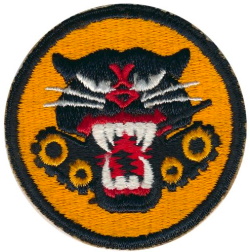
 CCB, under Gen John B. Thompson, encountered resistance in the outskirts of small villages surrounding Chartres. Gen Thompson divided his command into Force 1 under Col Leslie Allison consisting of the 23-AIB (less Baker and Charlie Cos); Dog Co, 31-TB, Able Co 179-AECB; A Btry 434-AFAB, Fox Co 87-CRS, and, Force 2, under Col Robert C. Erlenbusch, consisting of 31-TB (less Dog Co); Baker and Charlie Cos 23-AIB; the 434-AFAB (less A Btry); Charlie Co 179-AECB; Baker Co 814-TDB. Force 1 attacked the east from the northwest side of town while Force 2 attacked the northeast from the south of the town. The attack was preceded by a light artillery preparation from the 434-AFAB and the men jumped off at about 0800. Force 1 penetrated enemy defenses with infantry and established a CP within the northwest sector of the Town. Force 2 encountered heavy 20-MM and 88-MM AT fires in the suburbs of Lucé and Luisant. Force 2 penetrated to Chartres but due to losses and the inability of tanks to maneuver in the narrow streets of the town, was forced to withdraw to the west and re-group. The second attack on Chartres began the early morning of August 17, with the same composition of troops and additional artillery support from XX Corps artillery. However, on Corps order, the artillery was limited to observed point targets and all effort was made to spare the destruction of historic buildings.
CCB, under Gen John B. Thompson, encountered resistance in the outskirts of small villages surrounding Chartres. Gen Thompson divided his command into Force 1 under Col Leslie Allison consisting of the 23-AIB (less Baker and Charlie Cos); Dog Co, 31-TB, Able Co 179-AECB; A Btry 434-AFAB, Fox Co 87-CRS, and, Force 2, under Col Robert C. Erlenbusch, consisting of 31-TB (less Dog Co); Baker and Charlie Cos 23-AIB; the 434-AFAB (less A Btry); Charlie Co 179-AECB; Baker Co 814-TDB. Force 1 attacked the east from the northwest side of town while Force 2 attacked the northeast from the south of the town. The attack was preceded by a light artillery preparation from the 434-AFAB and the men jumped off at about 0800. Force 1 penetrated enemy defenses with infantry and established a CP within the northwest sector of the Town. Force 2 encountered heavy 20-MM and 88-MM AT fires in the suburbs of Lucé and Luisant. Force 2 penetrated to Chartres but due to losses and the inability of tanks to maneuver in the narrow streets of the town, was forced to withdraw to the west and re-group. The second attack on Chartres began the early morning of August 17, with the same composition of troops and additional artillery support from XX Corps artillery. However, on Corps order, the artillery was limited to observed point targets and all effort was made to spare the destruction of historic buildings.

 The troops of CCB encircled the town and pushed forces in from the southeast, and east, while a force remained occupying the northeast quarter. The Chartres garrison held positions facing the encirclement in the vicinity of Luisant, Le Coudray, and the high ground directly to the east of the town. Under this attack, the resistance was greatly reduced. It was evident that Chartres contained a larger garrison than had been estimated. It was a report station for disorganized and beaten units and stragglers from surrounding areas. The garrison was reinforced by an estimated 200-300 men during a 12-hour period. On August 18, a third attack was launched with the 11-RCT of the 5-ID. This attack completed the clearing of Chartres. The German dead were estimated at 1800, while 1500 prisoners were taken. Many vehicles and stores and two airfields in the vicinity together with 30 to 40 destroyed planes were also taken. CCB suffered approximately 100 casualties during the battle of Chartres.
The troops of CCB encircled the town and pushed forces in from the southeast, and east, while a force remained occupying the northeast quarter. The Chartres garrison held positions facing the encirclement in the vicinity of Luisant, Le Coudray, and the high ground directly to the east of the town. Under this attack, the resistance was greatly reduced. It was evident that Chartres contained a larger garrison than had been estimated. It was a report station for disorganized and beaten units and stragglers from surrounding areas. The garrison was reinforced by an estimated 200-300 men during a 12-hour period. On August 18, a third attack was launched with the 11-RCT of the 5-ID. This attack completed the clearing of Chartres. The German dead were estimated at 1800, while 1500 prisoners were taken. Many vehicles and stores and two airfields in the vicinity together with 30 to 40 destroyed planes were also taken. CCB suffered approximately 100 casualties during the battle of Chartres.
Bridgehead at Melun

 The 5-ID relieved the 7-AD on August 18 at Chartres. The 7-AD was ordered to move to the northwest to occupy Dreux and to protect the left flank and rear of the XV Corps. CCA proceeded directly to Dreux to relieve CCR of the 5-AD and to establish a defensive position to screen the assembling of the remainder of the 7-AD.
The 5-ID relieved the 7-AD on August 18 at Chartres. The 7-AD was ordered to move to the northwest to occupy Dreux and to protect the left flank and rear of the XV Corps. CCA proceeded directly to Dreux to relieve CCR of the 5-AD and to establish a defensive position to screen the assembling of the remainder of the 7-AD.

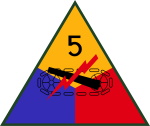 On August 20, Gen Walker visited the headquarters of this division and stated that he planned to move the Corps from its present position to seize crossings over the Seine River in the vicinity of Melun-Fontainebleau in accordance with directions from Gen George S. Patton, CG of the US 3-A. In this operation, the 5-ID was to be on the right to Fontainebleau. In Field Order #4 the 7-AD would attack as follows: CCB was to relieve CCA in its defensive position at Dreux; CCA and CCR were to move in two columns, CCR on the right to assault Melun, and CCA on the left, to reach the river, north of Melun.
On August 20, Gen Walker visited the headquarters of this division and stated that he planned to move the Corps from its present position to seize crossings over the Seine River in the vicinity of Melun-Fontainebleau in accordance with directions from Gen George S. Patton, CG of the US 3-A. In this operation, the 5-ID was to be on the right to Fontainebleau. In Field Order #4 the 7-AD would attack as follows: CCB was to relieve CCA in its defensive position at Dreux; CCA and CCR were to move in two columns, CCR on the right to assault Melun, and CCA on the left, to reach the river, north of Melun.
This attack began on the morning of August 21. CCA was composed of 40-TB, the 48-AIB, the 489-AFAB, Able Co 33-AECB; Able Co 814-TDB; and CCR, composed of the 33-TB (less Able Co), the 17-TB, 440-AFAB, the 814-TDB (less Able Co), Charlie Co 33-AECB, and Hqs & Hqs Btry, Division Artillery. The 87-CRS moved ahead of the division and protected the left flank with two reconnaissance troops. Both columns advanced steadily during the day against the intermittent rifle, machine gun, and mortar fire and secured their positions for the night of August 21, east of the Dourdan-Arpajon line. CCR continued to attack the next day to the outskirts of Melun. CCA was held up by artillery fire during the day in the vicinity of Arpajon. On August 23, CCA advanced to the Seine River at Tilly where the assault crossing was to be made. Meanwhile, CCB was relieved of its mission at Dreux and moved through Rambouillet to the outskirts of Corbeil where it remained until the assault crossing at Tilly was made.
As CCR approached within 5 miles of Melun to the south, the CG of the 7-AD personally came to deliver to the CO of CCR the order for the seizure and occupancy of the town of Melun. It was thought that the city would be strongly defended by a regiment of the 48.Infantry-Division. CCR proceeded on its mission. It met AT gunfire, heavy rifle, and MG fire, and at dark had been unable to proceed any further than one mile from the underpass. A coordinated attack was made at 2200. This was preceded by a 20-minute preparation by two battalions of 105-MM Howitzers (440-AFAB and 695-AFAB) and one battalion of 155-MM Howitzers (177-FAB).
